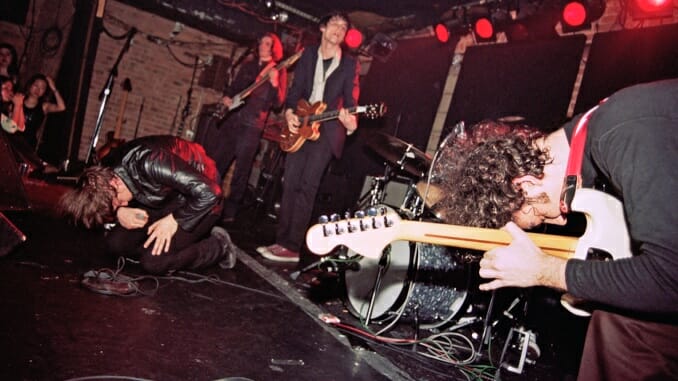Meet Me in the Bathroom Loses Its Lower East Side Edge

As a teenager, I was completely enamored by The Strokes, an obsession cemented when “Reptilia” played over the local tattoo parlor’s speakers while I was getting my nose pierced at 15. It was a trade-off I made with my parents for going through with the Catholic Sacrament of Confirmation, and having Julian Casablancas’ raspy voice narrating the experience made it feel all the more sexy, rebellious and special. Sure, perhaps it was a corny moment born of my own self-imposed Manic Pixie Dream Girl prison, but it also felt like a surefire sign that I, too, would one day reside in the alluring metropolis just a 20-minute drive away via Rte. 4 and the George Washington Bridge.
Of course, what I didn’t realize at the time was that the excitement and appeal of rock ’n’ roll’s ostensible rebirth in NYC was already facing its death knell. In their documentary Meet Me in the Bathroom, filmmakers Dylan Southern and Will Lovelace argue that the direct aftermath of 9/11 was both a creative boon and detriment to such artists living in New York, all constituting a scene born in Lower East Side dive bars and which eventually moved to Williamsburg warehouses. Based on the far more encompassing book by Lizzy Goodman of the same name, the film follows the inception of and eventual popular embrace of bands like The Moldy Peaches, LCD Soundsystem, the Yeah Yeah Yeahs and Interpol—with no musical act as integral to the entire package as The Strokes. Oddly enough, the presence of the actual musical alchemy that was conjured during this period is minimized in favor of mythologizing the people behind it. Instead of the film getting viewers pumped with, say, “All My Friends” or “Is This It,” it begins with Ed Begley reciting Walt Whitman’s “Give Me the Silent Splendid Sun,” an incredibly haughty sign that this documentary takes itself—and the artists-turned-celebrities it’s surveying—far too seriously. Even more peculiar is the near absence of New York City—specifically the Lower East Side—in the documentary itself, clearly eschewed in favor of centering the rubble of Lower Manhattan immediately after 9/11 and the subsequent mass migration to Brooklyn it kicked off.
What’s most compelling about the documentary is the archival footage (some previously unseen) of the bands during their first fledgling efforts, though the presence of the tangible music that shot these musicians to stardom remains elusive. Even so, the footage is less of a veritable well than a shallow pond—incredibly limited and revealing little depth. Viewers who didn’t necessarily witness the emergence of these bands but are still nostalgic for their presence in adolescent musical discoveries will be disappointed that the kinetic magic of The Strokes playing at Mercury Lounge or Karen O’s self-destructive performances aren’t at all palpable, even if interviews (mined from Goodman’s recordings for her own book) work tirelessly to contextualize the fleeting feeling. Important bits do manage to shine through, though: The Strokes hilariously fail upward despite their best efforts (though there’s regrettably no mention of Albert Hammond Jr.’s proclivity for whipping his testicles out as a party gag), Interpol slowly wade toward wider recognition, and DFA’s James Murphy feuds with anyone who has the misfortune of collaborating with him.
-

-

-

-

-

-

-

-

-

-

-

-

-

-

-

-

-

-

-

-

-

-

-

-

-

-

-

-

-

-

-

-

-

-

-

-

-

-

-

-








































